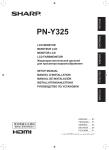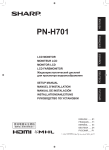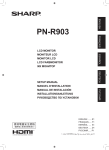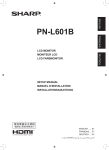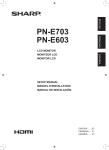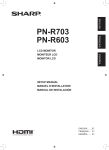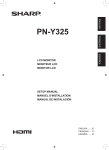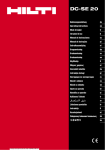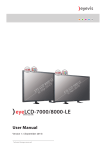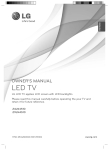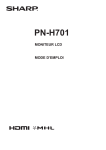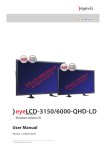Download PN-K322B - Sharp Australia Support
Transcript
ENGLISH FRANÇAIS PN-K322B LCD MONITOR MONITEUR LCD SETUP MANUAL MANUEL D’INSTALLATION 香港電器安全規格 (國際電工委員會規格適合) ENGLISH........ E1 FRANÇAIS...... F1 ( . ﺍﳌﺮﻓﻘﺔCD-ROM ) ﺍﻟﺪﻟﻴﻞ ﺑﺎﻟﻠﻐﺔ ﺍﻟﻌﺮﺑﻴﺔ ﻳﻮﺟﺪ ﰲ ﺃﺳﻄﻮﺍﻧﺔ Contents Adjustment of monitor position......................................5 Connections......................................................................6 Turning Power On/Off.......................................................7 Specifications...................................................................8 Mounting Precautions (For SHARP dealers and service engineers)..................8 ENGLISH IMPORTANT INFORMATION.............................................1 DEAR SHARP CUSTOMER...............................................1 SAFETY PRECAUTIONS...................................................2 SAFETY INSTRUCTION....................................................3 MOUNTING PRECAUTIONS.............................................4 Supplied Components......................................................5 [ENGLISH] Read the manuals in the “Manual” folder of the provided CD-ROM. (Adobe Reader is required to view the manuals.) IMPORTANT INFORMATION WARNING: TO REDUCE THE RISK OF FIRE OR ELECTRIC SHOCK, DO NOT EXPOSE THIS PRODUCT TO RAIN OR MOISTURE. CAUTION RISK OF ELECTRIC SHOCK DO NOT OPEN CAUTION: TO REDUCE THE RISK OF ELECTRIC SHOCK, DO NOT REMOVE COVER. NO USER-SERVICEABLE PARTS INSIDE. REFER SERVICING TO QUALIFIED SERVICE PERSONNEL. The lightning flash with arrowhead symbol, within a triangle, is intended to alert the user to the presence of uninsulated “dangerous voltage” within the product’s enclosure that may be of sufficient magnitude to constitute a risk of electric shock to persons. The exclamation point within a triangle is intended to alert the user to the presence of important operating and maintenance (servicing) instructions in the literature accompanying the product. DEAR SHARP CUSTOMER Thank you for your purchase of a SHARP LCD product. To ensure safety and many years of trouble-free operation of your product, please read the Safety Precautions carefully before using this product. 1 E SAFETY PRECAUTIONS Electricity is used to perform many useful functions, but it can also cause personal injuries and property damage if improperly handled. This product has been engineered and manufactured with the highest priority on safety. However, improper use can result in electric shock and/or fire. In order to prevent potential danger, please observe the following instructions when installing, operating and cleaning the product. To ensure your safety and prolong the service life of your LCD product, please read the following precautions carefully before using the product. 1. Read instructions — All operating instructions must be read and understood before the product is operated. 2.Keep this manual in a safe place — These safety and operating instructions must be kept in a safe place for future reference. 3. Observe warnings — All warnings on the product and in the instructions must be observed closely. 4. Follow instructions — All operating instructions must be followed. 5.Cleaning — Unplug the power cord from the AC outlet before cleaning the product. Use a dry cloth to clean the product. Do not use liquid cleaners or aerosol cleaners. 6.Attachments — Do not use attachments not recommended by the manufacturer. Use of inadequate attachments can result in accidents. 7.Water and moisture — Do not use the product near water. Do not install the product in a place where water may splash onto it. Be careful of equipment which drains water such as an air-conditioner. 8. Ventilation — The vents and other openings in the cabinet are designed for ventilation. Do not cover or block these vents and openings since insufficient ventilation can cause overheating and/or shorten the life of the product. Do not place the product on a sofa, rug or other similar surface, since they can block ventilation openings. Do not place the product in an enclosed place such as a bookcase or rack, unless proper ventilation is provided or the manufacturer’s instructions are followed. 9.Power cord protection — The power cords must be routed properly to prevent people from stepping on them or objects from resting on them. 10.The LCD panel used in this product is made of glass. Therefore, it can break when the product is dropped or applied with impact. Be careful not to be injured by broken glass pieces in case the LCD panel breaks. 11. Overloading — Do not overload AC outlets or extension cords. Overloading can cause fire or electric shock. 12.Entering of objects and liquids — Never insert an object into the product through vents or openings. High voltage flows in the product, and inserting an object can cause electric shock and/or short internal parts. For the same reason, do not spill water or liquid on the product. 13.Servicing — Do not attempt to service the product yourself. Removing covers can expose you to high voltage and other dangerous conditions. Request a qualified service person to perform servicing. 14.Repair — If any of the following conditions occurs, unplug the power cord from the AC outlet, and request a qualified service person to perform repairs. a. When the power cord or plug is damaged. b. When a liquid was spilled on the product or when objects have fallen into the product. c. When the product has been exposed to rain or water. d. When the product does not operate properly as described in the operating instructions. Do not touch the controls other than those described in the operating instructions. Improper adjustment of controls not described in the instructions can cause damage, which often requires extensive adjustment work by a qualified technician. e. When the product has been dropped or damaged. f.When the product displays an abnormal condition. Any noticeable abnormality in the product indicates that the product needs servicing. 15.Replacement parts — In case the product needs replacement parts, make sure that the service person uses replacement parts specified by the manufacturer, or those with the same characteristics and performance as the original parts. Use of unauthorized parts can result in fire, electric shock and/or other danger. 16.Safety checks — Upon completion of service or repair work, request the service technician to perform safety checks to ensure that the product is in proper operating condition. 17.Wall mounting — When mounting the product on a wall, be sure to install the product according to the method recommended by the manufacturer. 18.Heat sources — Keep the product away from heat sources such as radiators, heaters, stoves and other heat-generating products (including amplifiers). 19.Usage of the monitor must not be accompanied by fatal risks or dangers that, could lead directly to death, personal injury, severe physical damage or other loss, including nuclear reaction control in nuclear facility, medical life support system, and missile launch control in a weapon system. 20.Do not stay in contact with the parts of the product that become hot for long periods of time. Doing so may result in low-temperature burns. E 2 SAFETY PRECAUTIONS (Continued) This is a class A product. In a domestic environment this product may cause radio interference in which case the user may be required to take adequate counter measures. To maintain compliance with EMC regulations, use shielded cables to connect to the following terminals: HDMI input terminal and DisplayPort input terminal. ENGLISH WARNING: If a monitor is not positioned in a sufficiently stable location, it can be potentially hazardous due to falling. Many injuries, particularly to children, can be avoided by taking simple precautions such as: • Using fixing devices like wall mount brackets recommended by the manufacturer. • Only using furniture that can safely support the monitor. • Ensuring the monitor is not overhanging the edge of the supporting furniture. • Not placing the monitor on tall furniture (for example, cupboards or bookcases) without anchoring both the furniture and the monitor to a suitable support. • Not standing the monitors on cloth or other materials placed between the monitor and supporting furniture. • Educating children about the dangers of climbing on furniture to reach the monitor or its controls. Especially for child safety - Don’t allow children to climb on or play with the monitor. - Don’t place the monitor on furniture that can easily be used as steps, such as a chest of drawers. - Remember that children can become excited while watching a program, especially on a “larger than life” monitor. Care should be taken to place or install the monitor where it cannot be pushed, pulled over, or knocked down. - Care should be taken to route all cords and cables connected to the monitor so that they cannot be pulled or grabbed by curious children. SAFETY INSTRUCTION - Do not use the monitor where there is a lot of dust, where humidity is high, or where the monitor may come into contact with oil or steam. Do not use in an environment where there are corrosive gases (sulfur dioxide, hydrogen sulfide, nitrogen dioxide, chlorine, ammonia, ozone, etc.). As this could lead to fire. - Ensure that the monitor does not come into contact with water or other fluids. Ensure that no objects such as paper clips or pins enter the monitor as this could lead to fire or electric shock. - Do not place the monitor on top of unstable objects or in unsafe places. Do not allow the monitor to receive strong shocks or to strongly vibrate. Causing the monitor to fall or topple over may damage it. - Do not use the monitor near heating equipment or in places where there is likelihood of high temperature, as this may lead to generation of excessive heat and outbreak of fire. - Do not use the monitor in places where it may be exposed to direct sunlight. - The AC outlet shall be installed near the equipment and shall be easily accessible. - Do not display the same image for an extended time. The residual image will gradually disappear by displaying an animated image (etc.). The Power Cord and AC adapter - Use only the power cord and AC adapter supplied with the monitor. - When handling the AC adapter, observe the following: Incorrect handling may result in fire, electric shock, or injury. • Do not drop the AC adapter or subject it to impact. • Never disassemble the AC adapter. It contains high voltage parts that are dangerous to touch. • The AC adapter is for indoor use only. Do not use it outside. • Do not use the supplied AC adapter with other devices. - Do not damage the power cord and AC adapter nor place heavy objects on it, stretch it or over bend it. Also, do not add extension cords. Damage to the cord may result in fire or electric shock. - Do not use the power cord with a power tap. Adding an extension cord may lead to fire as a result of overheating. - Do not remove or insert the power plug with wet hands. Doing so could result in electric shock. - Unplug the power cord if it is not used for a long time. - Do not attempt to repair the power cord if it is broken or malfunctioning. Refer the servicing to the service representative. - Do not stay in contact with the parts of the product (touch panel, etc.) and the AC adapter that become hot for long periods of time. Doing so may result in low-temperature burns. - Do not fasten the AC adapter to the monitor or other equipment. Doing so may result in fire and electrical shock. 3 E MOUNTING PRECAUTIONS • This product is for use indoors. • A mounting bracket compliant with VESA specifications is required. • To install on a stand (commercially available) or on a wall, or to remove or move the monitor, consult your dealer. • Mounting the monitor on the wall requires special expertise and the work must be performed by an authorized SHARP dealer. You should never attempt to perform any of this work yourself. Our company will bear no responsibility for accidents or injuries caused by improper mounting or mishandling. • Use the monitor with the surface perpendicular to a level surface.If you are tilting the monitor without using the supplied stand, the monitor may be tilted up to 25 degrees upward or 20 degrees downward. • This monitor should be used at an ambient temperature between 41°F (5°C) and 95°F (35°C). Provide enough space around the monitor to prevent heat from accumulating inside. For the monitor in landscape orientation • When installing the monitor in landscape orientation, you can attach the supplied horizontal sticker (Operation buttons) to the front. Horizontal sticker (Operation buttons) • Use the supplied vertical sticker when you install the monitor in portrait orientation. Attach the vertical sticker (Operation buttons) to the back or the front. • Back Vertical sticker (Operation buttons) Unit: inch [cm] 7-7/8 [20] 1/8 [3.5] • Front Vertical sticker (Blank) 2 [5] 2 [5] 2 [5] For the monitor in portrait orientation Unit: inch [cm] 7-7/8 [20] 1/8 [3.5] Vertical sticker (Operation buttons) 2 [5] 2 [5] Cover Sharp logo 2 [5] For the monitor on the supplied stand Vertical sticker (Logo) Unit: inch [cm] Caution 2 [5] 27-19/64 [69.3] 2 [5] • If it is difficult to provide sufficient space for any reason such as the installation of the monitor inside a housing, or if the ambient temperature may be outside of the range of 41°F (5°C) to 95°F (35°C), install a fan or take other measures to keep the ambient temperature within the required range. • Do not block any ventilation openings. If the temperature inside the monitor rises, this could lead to a malfunction. • Do not place the monitor on a device which generates heat. E 4 • Adhere to the following when installing the monitor in its portrait orientation. Failing to adhere to the following may cause malfunctions. - Install the monitor such that the operation buttons are located on the top side. - Set the MONITOR on the MONITOR menu to PORTRAIT. (See OPERATION MANUAL.) Supplied Components If any component should be missing, please contact your dealer. ENGLISH Liquid Crystal Display Monitor: 1 Touch pen: 1 Cable cover: 1 Power cord: 1 AC adapter: 1 CD-ROM (Utility Disk for Windows): 1 Setup Manual (this manual): 1 DisplayPort cable: 1 RS-232C conversion cable (Φ3.5 mini-jack): 1 USB cable (for touch panel, miniB): 1 Cable clamp: 2 Cable clamp (small): 1 Cable clamp (large): 3 Anti-toppling clamp: 2 Screws (for anti-toppling) (M4 x 10): 2 Vertical sticker (Logo): 1 Vertical sticker (Operation buttons): 1 Vertical sticker (Blank): 1 Horizontal sticker (Operation buttons): 1 Cover Sharp logo: 1 (Place this sticker onto the SHARP logo to cover the logo.) * Sharp Corporation holds authorship rights to the Utility Disk program. Do not reproduce it without permission. Adjustment of monitor position You can slide the monitor to adjust its position. Use the monitor in the perpendicular position (about 90° from horizontal, Fig. A below) or slid to the bottommost position (about 25° from horizontal, Fig. B below). If used in any other position, the monitor may slide while in use. A A B B 25° When moving the monitor from the position of Fig. B to the position of Fig. A above, slightly lift the monitor (1) and slide toward the back (2). (2) (1) Caution • When sliding the monitor, be sure to grasp only the frame on the left and right sides. - Take care not to pinch your fingers. - Grasping and applying pressure to the LCD panel may damage it. - Take care not to press any buttons. This may cause the volume or other settings to change. 5 E Connections Caution • Be sure to turn off the main power switch and disconnect the plug from the power outlet before connecting/disconnecting cables. Also, read the manual of the equipment to be connected. • Be careful not to confuse the input terminal with the output terminal when connecting cables. Accidentally reversing cables connected to the input and output terminals may cause malfunctions and the other problems. • Do not use any cable that has a damaged or deformed terminal. Using such a cable may cause malfunctions. • Images may not be displayed properly depending on the computer (video cards), cables, or peripheral devices to be connected. 4 5 6 7 8 9 10 1. Main power switch 2. AC input terminal 3. Power cord (Supplied) 4. RS-232C input terminal 5. PC/AV HDMI1 input terminal 6. PC/AV HDMI2 input terminal 7. DisplayPort input terminal 8. Audio input terminal 9. USB (mini-B) port 10. Headphone terminal For power outlet 3 2 1 TIPS • Set the audio input terminal used for each input mode in AUDIO SELECT on the SETUP menu. The factory settings are shown below. Input mode DisplayPort HDMI1 [PC], HDMI1 [AV] HDMI2 [PC], HDMI2 [AV] Audio input terminal (Factory setting) DisplayPort input terminal PC/AV HDMI input terminal • The cables connected to the terminals on the rear of the monitor can be fastened with the cable clamp. Attach the cable clamps to the attachment parts on the back of the monitor and the stand, and bind the cables. Cable Cable clamp attachment Cable clamp Cable clamp (small) Cable clamp attachment Cable clamp (large) Cable Cable clamp attachment Cable • The terms HDMI and HDMI High-Definition Multimedia Interface, and the HDMI Logo are trademarks or registered trademarks of HDMI Licensing LLC in the United States and other countries. • DisplayPort is a registered trademark of Video Electronics Standards Association. E 6 Turning Power On/Off • Turn on the monitor first before turning on the PC or playback device. Turning on the main power Turning power on/off Press the power button ( ) to turn the power ON/OFF. To turn off the power, press and hold down the power button ( for about 2 seconds. Power button ( ) ) ENGLISH Caution Power LED Power lamp status Main power switch Caution • The main power must be turned on/off with the main power switch. Do not connect/disconnect the power cord or turn the breaker on/off while the main power switch is on. • When switching the main power switch off and back on, always wait for at least 5 seconds. • For a complete electrical disconnection, pull out the main plug. Status of the monitor Green lit Power on Off Power off (Standby mode) Orange lit Input signal waiting mode Caution • When switching the power button ( ) off and back on, always wait for at least 5 seconds. A short interval may result in a malfunction. TIPS • When the main power switch is off, the monitor cannot be turned on. • If the monitor is in the input signal standby mode and you press the power button ( ), the monitor enters standby mode. 7 E Specifications Model Power requirement Operating temperature Operating humidity Power consumption Dimensions (excluding protrusions) Weight PN-K322B AC 100 V - 240 V, 50/60 Hz (when using the supplied AC adapter) 41°F to 95°F (5°C to 35°C) 20% to 80% (no condensation) 97 W * (when using the supplied AC adapter) inch (mm) Monitor only Approx. 29-17/32(W) x 1-27/64(D) x 17-3/8(H) (750 x 36 x 441) Monitor on supplied stand • Monitor screen angle 90° (from horizontal) Approx. 29-17/32(W) x 15-23/64(D) x 19-27/64(H) (750 x 390 x 493) • Monitor screen angle 25° (from horizontal) Approx. 29-17/32(W) x 22-41/64(D) x 8-5/32(H) (750 x 575 x 207) lbs. (kg) Approx. 19.9 (9.0) (monitor only) Approx. 35.3 (16.0) (monitor on supplied stand) * When using the monitor in DC19.5 V : 91 W As a part of our policy of continuous improvement, SHARP reserves the right to make design and specification changes for product improvement without prior notice. The performance specification figures indicated are nominal values of production units. There may be some deviations from these values in individual units. Mounting Precautions (For SHARP dealers and service engineers) • When installing, removing or moving the monitor, ensure that this is carried out by at least 2 people. • Be sure to use a wall-mount bracket designed or designated for mounting the monitor. • This monitor is designed to be installed on a concrete wall or pillar. Reinforced work might be necessary for some materials such as plaster / thin plastic board / wood before starting installation. This monitor and bracket must be installed on a wall which can endure at least 4 times or more the weight of the monitor. Install by the most suitable method for the material and the structure. • To attach a VESA-compliant mounting bracket, use M6 screws that are 1/4 inch (6 mm) to 5/16 inch (8 mm) longer than the thickness of the mounting bracket. • Do not use an impact driver. • When moving the monitor, be sure to hold it with the unit bottom and the side of unit. Do not hold the LCD panel or corners. This may cause product damage, failure, or injury. • Do not use any screw holes other than VESA holes for installation. E 8 Table des matières INFORMATION IMPORTANTE..........................................1 CHER CLIENT....................................................................1 PRÉCAUTIONS DE SÉCURITÉ........................................2 MESURES DE SÉCURITÉ.................................................3 PRÉCAUTIONS POUR LE MONTAGE..............................4 Composants fournis.........................................................5 [FRANÇAIS] Réglage de la position du moniteur................................5 Connexions.......................................................................6 Mise sous tension et hors tension..................................7 Caractéristiques................................................................8 Précautions pour le montage (À l’attention des revendeurs et techniciens SHARP)....8 INFORMATION IMPORTANTE FRANÇAIS Lisez les manuels se trouvant dans le dossier “Manual” du CD-ROM fourni. (Adobe Reader est nécessaire pour pouvoir visualiser les manuels.) AVERTISSEMENT : POUR RÉDUIRE LE RISQUE D’INCENDIE OU DE DÉCHARGE ÉLECTRIQUE, NE PAS EXPOSER CE PRODUIT À LA PLUIE OU À LA POUSSIÈRE. Le symbole représenté par l’éclair à la tête en pointe de flèche à l’intérieur d’un triangle, est placé pour alerter l’utilisateur de la présence d’une “tension dangereuse” non isolée à l’intérieur du produit. Cette tension peut avoir une valeur suffisante pour constituer un risque d’électrocution à toute personne. ATTENTION RISQUE DE DÉCHARGE ÉLECTRIQUE NE PAS OUVRIR ATTENTION : POUR RÉDUIRE LE RISQUE DE DÉCHARGE ÉLECTRIQUE, NE PAS RETIRER LE COUVERCLE. IL N’Y A AUCUNE PIÈCE RÉPARABLE PAR L’UTILISATEUR À L’INTÉRIEUR. AVERTIR LE PERSONNEL DE SERVICE QUALIFIÉ POUR TOUTE PROCÉDURE D’ENTRETIEN. Le point d’exclamation à l’intérieur d’un triangle est placé pour alerter l’utilisateur de la présence d’une procédure particulière ou d’une procédure de maintenance (entretien) importante dans les manuels accompagnant le produit. CHER CLIENT Nous vous remercions d’avoir acheté cet appareil SHARP à écran LCD. Afin de garantir le bon fonctionnement de ce moniteur, nous vous conseillons de lire attentivement cette brochure et de la conserver pour toute référence ultérieure. 1 F PRÉCAUTIONS DE SÉCURITÉ L’électricité remplit de nombreuses fonctions utiles, mais elle peut provoquer des blessures et des dégâts matériels si elle n’est pas utilisée correctement. Cet appareil a été conçu et fabriqué en attachant la plus grande importance à la sécurité. Cependant, une utilisation inadéquate peut entraîner une décharge électrique et/ou un incendie. Afin d’éviter tout danger potentiel, veuillez respecter les consignes suivantes lors de l’installation, de l’utilisation et du nettoyage de l’appareil. Afin d’assurer votre propre sécurité et de prolonger la durée de service de votre moniteur LCD, veuillez lire attentivement les précautions ci-dessous avant d’utiliser l’appareil. 1.Lisez ces explications — Vous devez lire et comprendre toutes les informations relatives au fonctionnement de l’appareil avant de l’utiliser. 2.Conservez cette brochure dans un endroit sûr — Ces explications concernant la sécurité et le fonctionnement doivent être conservées dans un endroit sûr pour vous y référer en cas de besoin. 3.Respectez les avertissements — Tous les avertissements figurant sur l’appareil et dans ce mode d’emploi doivent être strictement respectés. 4.Suivez les instructions — Toutes les explications sur le fonctionnement doivent être respectées. 5.Nettoyage — Débranchez le cordon d’alimentation au niveau de la prise du secteur avant de nettoyer l’appareil. Servez-vous d’un linge sec, et n’employez pas de détergents liquides ou en atomiseur. 6.Accessoires — N’utilisez pas d’accessoires non recommandés par le fabricant, car ceci pourrait provoquer des accidents. 7.Eau et humidité — N’utilisez pas cet appareil près de l’eau. N’installez pas le produit à un endroit où il pourrait recevoir de l’eau. Évitez en particulier les emplacements sous les appareils à vidange d’eau tels que les climatiseurs. 8.Ventilation — Des ouïes et autres ouvertures sont prévues dans le coffret de l’appareil pour sa ventilation. Ne recouvrez pas et ne bouchez pas ces ouvertures car une ventilation insuffisante peut provoquer une surchauffe et réduire la durée de vie de l’appareil. Ne placez pas l’appareil sur un sofa, un tapis ou toute autre surface analogue car ceci pourrait obstruer les ouvertures de ventilation. Cet appareil n’est pas conçu pour une installation encastrée; ne le placez donc pas dans un endroit fermé comme une bibliothèque ou une baie à moins qu’une ventilation adéquate ne soit prévue et que les consignes du fabricant ne soient respectées. 9.Protection du cordon d’alimentation — Faites passer les cordons d’alimentation à un endroit où ils ne seront pas écrasés ou coincés par d’autres objets. 10.Le panneau de l’écran à cristaux liquides (LCD) de cet appareil est fabriqué en verre et, par conséquent, il peut se briser si l’appareil tombe ou s’il reçoit un fort impact. Veillez à ne pas vous blesser par les éclats de verre si le panneau LCD devait être brisé. 11.Surcharge — Ne surchargez pas les prises de courant ou les rallonges car ceci peut entraîner un risque d’incendie ou d’électrocution. 12.Insertion de solides ou de liquides — N’introduisez jamais des objets par les orifices de cet appareil, car ils pourraient provoquer une électrocution et/ou un court-circuit en touchant des pièces internes sous haute tension. Pour la même raison, ne renversez jamais de l’eau ou un liquide sur l’appareil. 13.Entretien — N’essayez pas de réparer vous-même l’appareil. La dépose des couvercles peut vous exposer à une haute tension ou à d’autres dangers. Confiez toute réparation à un personnel qualifié. 14.Réparation — Dans les cas suivants, débranchez le cordon d’alimentation au niveau de la prise secteur et demandez à un personnel qualifié d’effectuer les réparations. a. Dégât sur le cordon ou la prise de courant. b. Infiltration d’un liquide ou pénétration d’un objet à l’intérieur de l’appareil. c. Exposition de l’appareil à la pluie ou à l’eau. d. Fonctionnement anormal malgré une conformité aux explications du mode d’emploi. Ne réglez que les commandes dont il est fait mention dans le mode d’emploi. Un réglage incorrect des autres commandes peut provoquer des dégâts qui nécessiteraient des réparations complexes par un technicien spécialisé. e. Chute ou dégâts subis par l’appareil. f. Tout changement notoire ou situation anormale de l’appareil indique qu’une réparation est nécessaire. 15.Pièces de rechange — Lorsque des pièces doivent être remplacées, assurez-vous que le technicien a utilisé les pièces spécifiées par le fabricant ou des pièces dont les performances et les caractéristiques sont identiques. Des changements non autorisés de pièces peuvent entraîner un incendie, une électrocution et/ou d’autres dangers. 16.Contrôles de sécurité — Après une intervention d’entretien ou de réparation, demandez au technicien de procéder à un contrôle pour être sûr que l’appareil peut être utilisé en toute sécurité. 17.Installation sur paroi — Si l’appareil doit être fixé sur une paroi, installez-le en respectant la méthode recommandée par le fabricant. 18.Sources de chaleur — Tenez l’appareil à l’écart de sources de chaleur, telles que radiateurs, dispositifs de chauffage, poêles et autres appareils dégageant de la chaleur (y compris les amplificateurs). 19.L’utilisation de ce moniteur ne doit pas entraîner des risques mortels ou des dangers qui pourraient provoquer directement la mort, des blessures sur le personnel, des dommages physiques sévères ou d’autres destructions, y compris dans le contrôle des réactions nucléaires dans les installations nucléaires, dans le système médical de réanimation, et dans le contrôle de lancement des missiles dans les systèmes d’armes. 20.N’entrez pas en contact direct avec les parties du produit ayant chauffé pendant de longues périodes. Il pourrait en résulter des brûlures à basse température. F 2 PRÉCAUTIONS DE SÉCURITÉ (Suite) AVERTISSEMENT : Ce produit appartient à la Classe A. Dans un environnement résidentiel, il peut provoquer des interférences radio et, dans ce cas, l’utilisateur peut être obligé de prendre les mesures nécessaires. Afin de satisfaire aux normes EMC, utiliser des câbles blindés pour connecter les bornes suivantes : Borne d’entrée HDMI et borne d’entrée DisplayPort. FRANÇAIS Un moniteur placé sur un support instable est dangereux en raison des risques de chute qu’il présente. De nombreuses blessures, touchant en particulier les enfants, peuvent être évitées en prenant quelques précautions simples : • Utiliser les dispositifs de fixation tels que les supports muraux fournis par le fabricant. • Utiliser uniquement des meubles capables d’accueillir le moniteur en toute sécurité. • Vérifier que le moniteur ne dépasse pas du bord du meuble sur lequel il est posé. • Ne pas placer le moniteur sur des meubles hauts, armoires ou étagères, par exemple, sans fixer le meuble concerné et le moniteur à un support approprié. • Ne pas intercaler de tissu ou toute autre matière entre le moniteur et le meuble sur lequel il est posé. • Expliquer aux enfants qu’il est dangereux de grimper sur les meubles pour atteindre le moniteur ou ses boutons de commande. En particulier pour la sécurité des enfants - Ne laissez pas les enfants grimper sur ou jouer avec le moniteur. - Ne placez pas le moniteur sur des meubles qui peuvent facilement se transformer en marches comme une commode avec tiroirs. - Souvenez-vous que les enfants s’excitent souvent en visionnant un programme, surtout sur un moniteur « plus grand que la normale ». Il faut faire en sorte d’installer le moniteur là où il ne peut pas être poussé, tiré, ni basculé. - Il faut faire en sorte de placer les fils et les câbles connectés au moniteur de façon à ce que des enfants curieux ne puissent pas les tirer ni les saisir. MESURES DE SÉCURITÉ - N’utilisez pas le moniteur dans un endroit où il y a beaucoup de poussières, où le degré d’humidité est élevé, ou encore là où il pourrait se trouver en contact avec de l’huile ou de la vapeur. Ne l’utilisez pas non plus dans un environnement contenant des gaz corrosifs (dioxyde de soufre, sulfure d’hydrogène, dioxyde d’azote, chlore, ammoniac, ozone, etc.). Cela pourrait provoquer un début d’incendie. - Assurez-vous que le moniteur ne se trouve pas en contact avec de l’eau ou d’autres fluides. Assurez-vous qu’aucun objet tel que des agrafes et des trombones ne pénètre dans le moniteur, car cela pourrait provoquer un début d’incendie ou un choc électrique. - N’installez pas le moniteur au dessus des objets instables ou dans des endroits peu sûrs. Faites attention que le moniteur ne reçoive pas de chocs violents ni de fortes vibrations. Provoquer la chute du moniteur ou le culbuter peut l’endommager. - N’utilisez pas le moniteur à proximité d’un appareil de chauffage ou dans des endroits où la température est élevée, car cela pourrait conduire à un dégagement excessif de chaleur et provoquer un début d’incendie. - N’utilisez pas le moniteur dans des endroits exposés directement à la lumière du soleil. - La prise de secteur doit être installée près de l’équipement et être facilement accessible. - N’affichez pas la même image pendant une longue période. L’affichage d’une image animée (etc.) fera disparaître progressivement l’image rémanente. Le cordon d’alimentation et l’adaptateur secteur - Utilisez uniquement le cordon d’alimentation et l’adaptateur secteur fournis avec le moniteur. - Lorsque vous manipulez l’adaptateur secteur, respectez les instructions suivantes : Une mauvaise manipulation peut provoquer un incendie, un choc électrique ou des blessures. • Ne laissez pas tomber l’adaptateur secteur ou ne le soumettez pas à un choc. • Ne démontez jamais l’adaptateur secteur. Il contient des pièces sous haute tension dangereuses à toucher. • L’adaptateur secteur est destiné à être utilisé à l’intérieur uniquement. Ne l’utilisez pas à l’extérieur. • N’utilisez pas l’adaptateur secteur fourni avec d’autres appareils. - N’endommagez pas le cordon d’alimentation, ni l’adaptateur secteur, ne déposez pas d’objets lourds sur ceux-ci, ne tirez pas dessus et ne les pliez pas de manière excessive. De même, n’ajoutez pas de rallonges. Tout endommagement du cordon d’alimentation peut provoquer un début d’incendie ou un choc électrique. - Ne branchez pas le cordon d’alimentation sur une prise multiple. Ajouter une rallonge peut entraîner une surchauffe et provoquer un début d’incendie. - Ne débranchez pas, ni ne branchez la prise d’alimentation avec des mains humides. En ce faisant, vous risquez un choc électrique. - Débranchez le cordon d’alimentation si l’équipement n’est pas utilisé pendant une longue période. - Ne tentez pas de réparer le cordon d’alimentation s’il est coupé ou s’il ne fonctionne pas correctement. Veuillez prendre contact avec le service après vente et suivre ses recommandations. - N’entrez pas en contact direct avec les parties du produit (écran tactile, etc.) et de l’adaptateur secteur ayant chauffé pendant de longues périodes. Il pourrait en résulter des brûlures à basse température. - Ne fixez pas l’adaptateur secteur au moniteur ou à un autre matériel. Ceci pourrait provoquer un incendie ou un choc électrique. 3 F PRÉCAUTIONS POUR LE MONTAGE • Ce produit est destiné à être utilisé en intérieur. • Un support de montage conforme aux spécifications VESA est nécessaire. • Pour installer le moniteur sur un support (en vente dans le commerce) ou sur un mur, ou pour le démonter ou le déplacer, consultez votre revendeur. • Le montage du moniteur sur le mur demande des compétences techniques spéciales et le travail doit être fait par un revendeur agréé par SHARP. Vous ne devez jamais tenter de faire ce travail vous-même. Notre société déclinera toute responsabilité pour les accidents ou blessures causés par un montage incorrect ou par une mauvaise manipulation. • Utilisez le moniteur perpendiculairement à la surface horizontale. Vous pouvez incliner le moniteur de 25 degrés vers le haut ou de 20 degrés vers le bas sans utiliser le support fourni. • Ce moniteur doit être utilisé sous une température ambiante entre 5°C et 35°C. Laissez assez d’espace autour du moniteur pour empêcher que la chaleur ne s’accumule à l’intérieur. Pour le moniteur dans une direction horizontale Unité : cm 20 5 • Lorsque vous installez le moniteur dans une direction horizontale, vous pouvez fixer l’autocollant horizontal (Boutons de fonctionnement) fourni à l’avant. Autocollant horizontal (Boutons de fonctionnement) • Utilisez l’autocollant vertical quand vous installez le moniteur dans une direction verticale. Fixez l’autocollant vertical (Boutons de fonctionnement) à l’arrière ou à l’avant. • Arrière Autocollant vertical (Boutons de fonctionnement) • Avant 3,5 Autocollant vertical (Vierge) 5 5 Pour le moniteur dans une direction verticale Unité : cm 20 5 3,5 Autocollant vertical (Boutons de fonctionnement) 5 Logo Sharp sur le couvercle 5 Autocollant vertical (Logo) Pour le moniteur sur le support fourni Unité : cm Attention 5 69,3 5 • S’il est difficile de laisser un espace suffisant pour une raison ou pour une autre (installation du moniteur dans une enceinte, par exemple) ou si la température ambiante est susceptible de dépasser la plage de valeurs prévue (de 5 à 35°C), installez un ventilateur ou prenez d’autres mesures appropriées pour maintenir la température ambiante dans la plage de valeurs requise. • Ne bloquez pas les ouvertures de ventilation. Si la température dans le moniteur s’élève, ceci pourrait causer un dysfonctionnement. • Ne placez le moniteur sur un équipement qui dégage de la chaleur. F 4 • Respectez la condition suivante quand vous installez le moniteur dans la direction verticale. Le non respect de cette condition peut causer des dysfonctionnements. - Installez le moniteur de sorte que les boutons de fonctionnement soient situés vers le haut. - Réglez le MONITOR <MONITEUR> sur PORTRAIT dans le menu MONITOR <MONITEUR>. (Voir le MODE D’ENPLOI.) Composants fournis Si un composant venait à manquer, veuillez contacter votre revendeur. Moniteur à cristaux liquides : 1 Stylet : 1 Protège-câbles : 1 Cordon d’alimentation : 1 Adaptateur secteur : 1 CD-ROM (Utility Disk pour Windows) : 1 Manuel d’Installation (ce manuel) : 1 Câble DisplayPort : 1 Câble de conversion RS-232C (mini-prise ø3,5) : 1 Câble USB (pour écran tactile, mini-B) : 1 Serre-câble : 2 Serre-câble (petit) : 1 Serre-câble (grand) : 3 Fixation anti-basculement : 2 Vis (anti-basculement) (M4 x 10) : 2 Autocollant vertical (Logo) : 1 Autocollant vertical (Boutons de fonctionnement) : 1 Autocollant vertical (Vierge) : 1 Autocollant horizontal (Boutons de fonctionnement) : 1 Logo Sharp sur le couvercle : 1 (Placez cet autocollant sur le logo SHARP pour le couvrir.) * Sharp Corporation détient les droits d’auteur du programme de l’Utility Disk. Veuillez ne pas le reproduire sans autorisation de la société. Vous pouvez faire pivoter le moniteur pour ajuster sa position. Utilisez le moniteur en position perpendiculaire (à environ 90° de l’horizontale, Fig. A ci-dessous) ou dans la position la plus basse (à environ 25° de l’horizontale, Fig. B ci-dessous). Si vous l’utilisez dans toute autre position, le moniteur risque de pivoter en cours d’utilisation. A FRANÇAIS Réglage de la position du moniteur A B B 25° Lorsque vous faites passer the moniteur de la position de la Fig. B à la position de la Fig. A ci-dessus, levez légèrement le moniteur (1) et faites-le pivoter en arrière (2). (2) (1) Attention • Lorsque vous faites pivoter le moniteur, assurez-vous de ne saisir que le cadre des deux côtés. - Veillez à ne pas pincer vos doigts. - Saisir et appliquer une pression sur le panneau LCD peut l’endommager. - Veillez à n’appuyer sur aucun bouton. Le volume ou d’autres réglages pourraient s’en trouver modifiés. 5 F Connexions Attention • Veillez à bien mettre hors tension l’interrupteur principal puis débranchez la prise de l’alimentation secteur avant de connecter ou de déconnecter les câbles. Lisez également le manuel de l’équipement à connecter. • Veillez à ne pas confondre la borne d’entrée avec la borne de sortie quand vous connectez les câbles. En confondant les câbles branchés aux bornes d’entrée et de sortie, vous pouvez causer des dysfonctionnements et d’autres problèmes. • N’utilisez pas de câble ayant un terminal endommagé ou déformé. Cela pourrait causer des dysfonctionnements. • Les images peuvent ne pas s’afficher correctement selon l’ordinateur (cartes vidéo), les câbles ou les périphériques connectés. 4 5 6 7 8 9 10 1. Interrupteur principal 2. Borne d’entrée secteur 3. Cordon d’alimentation (fourni) 4. Borne d’entrée RS-232C 5. Borne d’entrée PC/AV HDMI1 6. Borne d’entrée PC/AV HDMI2 7. Borne d’entree DisplayPort 8. Borne d’entrée audio 9. Port USB (mini-B) 10. Borne des écouteurs Vers la prise d’alimentation secteur 3 2 1 Conseils • Réglez la borne d’entrée audio utilisée pour chaque mode d’entrée dans AUDIO SELECT <SÉLECTION ENTRÉE AUDIO> du menu SETUP <INSTALLATION>. Les réglages par défaut sont indiqués ci-dessous. Mode d’entrée Borne d’entrée audio (paramètre d’origine) DisplayPort HDMI1 [PC], HDMI1 [AV], HDMI2 [PC], HDMI2 [AV] Borne d’entree DisplayPort Borne d’entrée PC/AV HDMI • Les câbles raccordés aux bornes situées à l’arrière du moniteur peuvent être attachés à l’aide du serre-câbles. Fixez les serre-câbles dans les pièces de fixation à l’arrière du moniteur et du support, et reliez les câbles. Câble Fixation du serre-câble Serre-câbles Serre-câble (petit) Fixation du serre-câble Serre-câble (grand) Câble Fixation du serre-câble Câble • Les désignations HDMI et HDMI High-Definition Multimedia Interface ainsi que le logo HDMI sont des marques de commerce ou des marques déposées de la société HDMI Licensing LLC aux États-Unis et dans d’autres pays. • DisplayPort est une marque depose de Video Electronics Standards Association. F 6 Mise sous tension et hors tension Attention • Mettez sous tension le moniteur d’abord avant de mettre sous tension le PC ou l’équipement de lecture. Mise sous tension de l’interrupteur principal Mise sous/hors tension Appuyez sur la bouton POWER ( ) ou sur l’interrupteur d’alimentation pour mettre sous/hors tension. Pour mettre le moniteur hors tension, maintenez le bouton POWER ( ) enfoncé pendant 2 secondes environ. Bouton POWER ( ) Diode d’alimentation État du témoin d’alimentation Attention • La mise sous/hors doit être effectuée à l’aide de l’interrupteur d’alimentation. Ne branchez/débranchez pas le cordon d’alimentation ou ne mettez pas le disjoncteur sous/hors tension lorsque l’interrupteur d’alimentation est en position marche. • Lors de la mise hors tension et de la remise sous tension en appuyant sur l’interrupteur principal, attendez toujours au moins 5 secondes. • Pour déconnecter complètement l’alimentation électrique, retirez la fiche principale de la prise. Allumé en vert Éteint Allumé en orange FRANÇAIS Interrupteur principal État du moniteur Power en position marche Power en position arrêt (mode Veille) Mode attente du signal d’entrée Attention • Lors de la mise hors tension et de la remise sous tension en appuyant sur le bouton POWER ( ), attendez toujours au moins 5 secondes. Un court intervalle peut entraîner un dysfonctionnement. Conseils • Lorsque l’interrupteur principal est en position arrêt, il est impossible de mettre le moniteur en marche. • Si le moniteur est dans le mode veille du signal d’entrée et que vous appuyez sur le bouton POWER ( ), le moniteur entre en mode veille. 7 F Caractéristiques Modèle Alimentation Température de fonctionnement Hygrométrie de fonctionnement Consommation électrique Dimensions (à l’exclusion des éléments qui dépassent) Poids PN-K322B CA 100 V - 240 V, 50/60 Hz (en utilisant l’adaptateur secteur fourni) 5°C à 35°C 20 % à 80 % (sans condensation) 97 W * (en utilisant l’adaptateur secteur fourni) (mm) Moniteur uniquement Environ 750 (L) x 36 (P) x 441 (H) Moniteur sur le support fourni • Angle de l’écran du moniteur : 90° (par rapport à l’horizontale) Environ 750 (L) x 390 (P) x 493 (H) • Angle de l’écran du moniteur : 25° (par rapport à l’horizontale) Environ 750 (L) x 575 (P) x 207 (H) (kg) Approx. 9,0 (moniteur uniquement) Approx. 16,0 (moniteur sur le support fourni) * Lors de l’utilisation du moniteur en CC19,5 V : 91 W SHARP se réserve le droit d’apporter des modifications à la présentation et aux caractéristiques des appareils à fin d’amélioration. Les valeurs indiquées dans ce document sont les valeurs nominales des appareils de série mais de légères différences peuvent être constatées d’un appareil à l’autre. Précautions pour le montage (À l’attention des revendeurs et techniciens SHARP) • L’installation, le démontage ou le déplacement du moniteur doit être fait par 2 personnes ou plus. • Veillez à utiliser un support mural conçu ou prévu pour la fixation du moniteur. • Ce moniteur est prévu pour être installé sur un mur ou un pilier en béton. Un travail de renforcement pourrait s’avérer nécessaire pour certains matériaux tels que le plâtre, un mince panneau de plastique ou le bois avant de commencer l’installation. Le mur sur lequel ce moniteur et le support doivent être installés doit pouvoir supporter, au moins, 4 fois son poids ou davantage. Installez de la manière qui convient le mieux en fonction du matériau et de la structure. • Pour fixer un support de montage compatible avec VESA, utilisez des vis M6 de 6 mm à 8 mm plus longues que l’épaisseur du support de montage. • N’utilisez pas de tournevis à percussion. • Lorsque vous déplacez le moniteur, assurez-vous de le saisir sur le bas de l’unité et le côté de l’unité. Ne saisissez pas le panneau LCD ou les angles. Ceci pourrait causer une panne, un dysfonctionnement ou une blessure. • N’utilisez pas de trous de vis autres que les trous standard VESA pour l’installation. F 8 Printed in China Imprimé en Chine 13F YT1 TINSM1297MPZZ(1)




















